
Ducati Diavel Service Manual: Refitting the fuel tank fairings
Make sure that the following components are fitted on the tank fairing (22):
- Spacers (18);
- Seals (20).
Fit the clips (19) to the central cover (22) at the positions shown, inserting the tabs (h) into the slots (l).
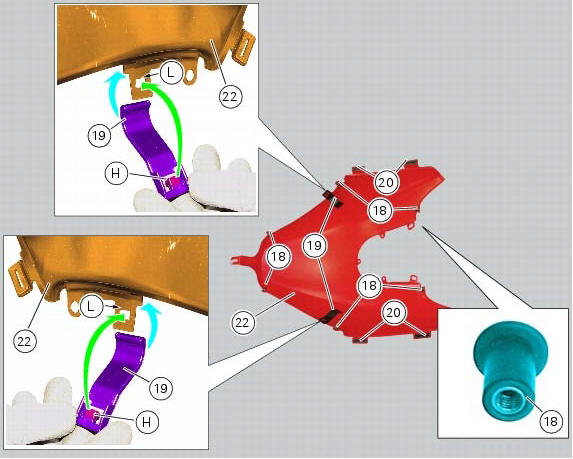
Apply threadlocker to the screws (14).
Place the tank fairing (22) on the tank and keep it in position by starting the screws (14) together with the relevant nylon washers (15).
Tighten to torque of 2 nm +/-10% (sect. 3 - 3, Frame torque settings) the screws (14).

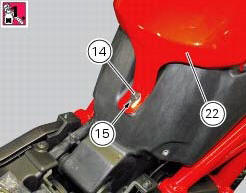
Fit the tank lh fairing (21) and keep it in position by starting the screws (16) together with the relevant washers (17).
Apply some threadlocker on the screw (14), fit the nylon washer (15) and start the screw.
Tighten the screw (14) to a torque of 2 nm +/- 10% (sect. 3 - 3, Frame torque settings) and the screws (16) to a torque of 0.33 Nm +/-10% (sect. 3 - 3, Frame torque settings).

Fit the tank rh fairing (13) and keep it in position by starting the screws (16) together with the relevant washers (17).
Apply some threadlocker on the screw (14), fit the nylon washer (15) and start the screw.
Tighten the screw (14) to a torque of 2 nm +/- 10% (sect. 3 - 3, Frame torque settings) and the screws (16) to a torque of 0.33 Nm +/-10% (sect. 3 - 3, Frame torque settings).
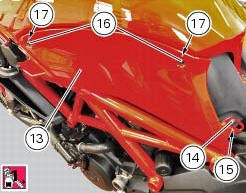
Fit the vibration dampers (g) to the master dashboard (f).
Insert the spacers with collar (j) onto the vibration dampers (g).
Fit the vibration damper (20) to the tank plug cover (23) at the position shown.
Important
On refitting, make sure that the vibration damper (20) is fully in place.
Fit the master dashboard (f) on the tank plug cover (23) inserting tab (l) into the vibration damper (20).

Fix the master dashboard (f) to the cover (23) by tightening the screws (m) to a torque of 2 nm +/- 10% (sect. 3 - 3, Frame torque settings).

Place the tank plug cover (23) on the vehicle and connect connector (e) to the dashboard (f); push connector until an audible click indicates proper engagement.
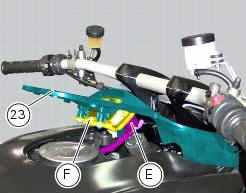
Apply threadlocker to the screws (25).
Fit the tank plug cover (23), fit spacers (24), and start screws (25) and screws (16).
Tighten the screws (25) to a torque of 2 nm +/- 10% (sect. 3 - 3, Frame torque settings) and the screws (16) to a torque of 0.33 Nm +/-10% (sect. 3 - 3, Frame torque settings).
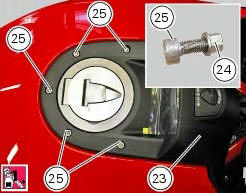

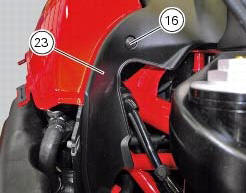
Lubricate the seals (d) of the central tank cover (22) using lubricant specific for rubber.
Position the front rh half-fairing (1) by inserting the tabs (c) into the seals (d) pushing downwards (blue arrows); after that, slide the half-fairing completely to the rear side of the motorcycle (red arrows).
Block the front rh half-fairing (1) by forcing pin (a) into the receptacle (b) in the rh water radiator.
Warning
Before pushing on the pin (a), make sure it is centred in the receptacle hole (b). Then - and not until after checking for proper position - push moderately and increasingly harder until you hear the component engage.
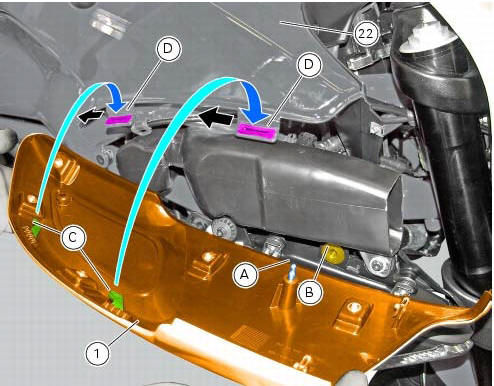
Before tightening the screws securing the front left half-fairing (12) and the front right half-fairing (1), proceed as follows: visually check the distance between the front left half-fairing (12) and the central tank cover (22) along the upper mating edges of both parts.
Visually check the distance between the front right half-fairing (1) and the central tank cover (22) along the upper mating edges of both parts.
If the parts do not mate equally, shift the front half-fairings (12) and (1) forward or backward as required until achieving a condition in which the half-fairings (12) and (1) are at the same distance from the central tank cover (22).
After tightening, check again to ensure that the front half-fairings (12) and (1) are at the same distance from the tank cover (22). If not so, repeat the above procedure.
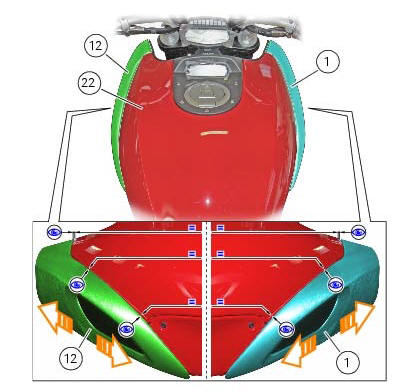
Fix the front rh half-fairing (1) by tightening the screw (3) to a torque of 0.33 Nm +/- 10% (sect. 3 - 3, Frame torque settings).
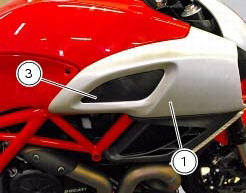
Follow the same procedure to reassemble the lh half-fairing (12).

Apply threadlocker to the screws (9).
Fit the rh air inlet (7) and fix it to the tank plug cover (23) by starting the screws (6) and (9).
Tighten the screws (9) to a torque of 2 nm +/- 10% (sect. 3 - 3, Frame torque settings) and the screws (6) to a torque of 1.5 Nm +/-10% (sect. 3 - 3, Frame torque settings).
The procedure is the same for the lh air inlet (8).
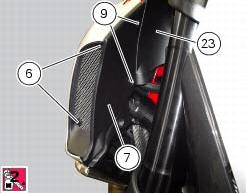

 Reassembly of the front half-fairings
Reassembly of the front half-fairings
Fit the clips (2) on the front rh half-fairing (1).
Join the rh support (4) and the front rh half-fairing (1) and keep them in
position by starting the screws (5).
Note
To mount the rh suppor ...
 Seat
Seat
Seat
Seat cover
Rubber mounting
Special screw
Plate
Latch
Spare parts catalogue
Diavel abs seat
Diavel carbon
abs
seat
Important
Bold reference numbers in this section identi ...
Other materials:
Refitting the throttle twistgrip
Lubricate the ends of the throttle grip cables (10) and the twistgrip race
with the recommended grease.
The closing cable (10) features a writing on the yellow tube, whereas the
opening one (10) features such writing on the
white tube.
To refit the throttle control components, proceed i ...
Hands free
Hands free
Special screw
Plug
Electric fuel plug
Button
Spring
Frame
Elastic pin
Spare parts catalogue
Diavel abs handlebar and controls
Diavel carbon
abs
handlebar and controls
Important
Bold reference numbers in this section identify parts not shown in the
figures a ...
Checking the camshafts and supports
Check the cam contact surfaces for scratches, grooves, steps and waving.
Worn cams are frequently the cause of poor timing, which leads to loss of engine
power.
Place the camshaft between two centres and check the run-out on the areas
indicated using two dial gauges.
Service limit: 0.1 ...